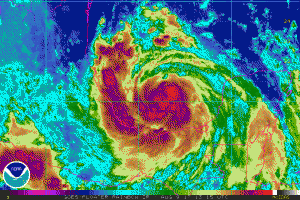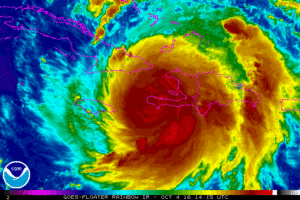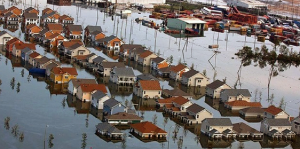
Even if a hurricane isn’t an immediate threat, residents along the US East Coast, Gulf Coast, and Hawaii should be prepared for hurricanes anytime in hurricane season. In the Atlantic and Central Pacific, Hurricane Season runs from June 1 to November 30 each year. By knowing what actions to take before, during, and after a storm’s arrival, you can increase your chance of survival.
Hurricanes aren’t the only danger from the tropics: while lacking the potent winds that hurricanes have, tropical depressions and tropical storms can be devastating too. The primary hazards from tropical cyclones (which include tropical depressions, tropical storms, and hurricanes) are storm surge flooding, inland flooding from heavy rains, destructive winds, tornadoes, and high surf and rip currents.

Storm surge is the abnormal rise of water generated by a storm’s winds. This hazard is historically the leading cause of hurricane related deaths in the United States. Storm surge and large battering waves can result in large loss of life and cause massive destruction along the coast. Storm surge can travel several miles inland, especially along bays, rivers, and estuaries. You don’t need to live on a beach to fall victim to storm surge flooding, as residents of New Jersey and New York learned in the wake of Hurricane Sandy.
Flooding from heavy rains is the second leading cause of fatalities from landfalling tropical cyclones. Widespread torrential rains associated with these storms often cause flooding hundreds of miles inland. This flooding can persist for several days after a storm has dissipated.

Winds from a hurricane can destroy buildings and manufactured homes. Signs, roofing material, and other items left outside can become flying missiles during hurricanes. Depending on local building codes, many homes may be built to only withstand winds of 100mph; major hurricanes have much higher winds than that and could lead to catastrophic destruction of even strong homes.
Tornadoes can accompany landfalling tropical cyclones. These tornadoes typically occur in rain bands well away from the center of the storm. While not as strong as tornadoes that form in supercell complexes, these tornadoes add an additional element of danger to a landfalling tropical cyclone.
Dangerous waves produced by a tropical cyclone’s strong winds can pose a significant hazard to coastal residents and mariners. These waves can cause deadly rip currents, significant beach erosion, and damage to structures along the coastline, even when the storm is more than a 1,000 miles offshore.
BEFORE
Before a hurricane or tropical cyclone threatens your area, you should be prepared and have a plan.
- Know Your Zone: Do you live near the Gulf or Atlantic Coasts? Find out if you live in a hurricane evacuation area by contacting your local government/emergency management office.
- Put Together an Emergency Supplies Kit: Put together a basic emergency kit, complete with fresh batteries, flashlights, radios, water, and non-perishable food. You should have at least 3 days worth of supplies in your kit and you should make sure items are fresh and/or working in every season.
- Check Emergency Equipment: Beyond flashlights, make sure other things such as generators and storm shutters are in good condition.
- Write or review your Family Emergency Plan: The best time to craft an emergency plan is when there is no emergency. In the calm before a tropical cyclone impact, preferably before or at the start of Hurricane Season, sit down with your family or close friends and decide how you will get in contact with each other, where you will go, and what you will do in an emergency. Keep a copy of this plan in your emergency supplies kit or another safe place where you can access it in the event of a disaster.
- Review Your Insurance Policies: Review your insurance policies to ensure that you have adequate coverage for your home and personal property. Remember: many policies have a waiting period to make claims; it may be necessary to get coverage well ahead of Hurricane Season to have effective coverage that season.
- Understand National Weather Service and National Hurricane Center advisories: Know the difference between watches and warnings and know what to do when any advisory for any tropical cyclone is issued for your area. Have a reliable way to get those advisories; the internet may not be working properly right before or during a tropical cyclone impact.
DURING
When a hurricane threatens your home, be prepared to evacuate if you live in a storm surge risk area. Listen to the guidance of local officials; if winds are strong enough, they may encourage you to evacuate too. Otherwise, they may recommend that you shelter in place if you aren’t in danger of flooding. Be sure to allow enough time to pack and inform friends and family if you need to leave your home.
- Secure your home: Cover all of your home’s windows. Permanent storm shutters offer the best protection for windows. A second option is to board up windows with 5/8 inch exterior grade or marine plywood, built to fit, and ready to install. Buy supplies before the hurricane season rather than waiting for the pre-storm rush.
- Stayed tuned in: Listen to NOAA Weather Radio or other trusted weather sources for the latest storm news.
- Follow instructions issued by local officials: Leave immediately if ordered to evacuate!
- If NOT ordered to evacuate:
- Take refuge in a small interior room, closet, or hallway on the lowest level during the storm. Put as many walls between you and the outside as you can.
- Stay away from windows, skylights, and glass doors.
- If the eye of the storm passes over your area, there will be a short period of calm, but at the other side of the eye, the wind speed rapidly increases to hurricane force winds coming from the opposite direction.
AFTER
Many dangers remain once a storm passes through.
- Follow local news: tune into NOAA Weather Radio or other trusted news sources for the latest updates and guidance on the storm,
- Return home only when told it’s OK: If you evacuated, return home only when officials say it is safe.
- Be extra-cautious when returning home: Once home, drive only if necessary and avoid flooded roads and washed-out bridges. If you must go out, watch for fallen objects in the road, downed electrical wires, and weakened walls, bridges, roads, and sidewalks that might collapse.
- Check your home for damage: Walk carefully around the outside of your home to check for loose power lines, gas leaks, and structural damage. Stay out of any building if you smell gas, if floodwaters remain around the building, if the building or home was damaged by fire, and/or if the authorities have not declared it safe.
- Use generators with caution: Carbon monoxide poisoning is one of the leading causes of death after storms in areas dealing with power outages. Never use a portable generator inside your home or garage.
- If power is out, only use battery operated lights: Use battery-powered flashlights and lanterns; do NOT use candles. Turn on your flashlight before entering a vacated building. The battery could produce a spark that could ignite leaking gas, if present.